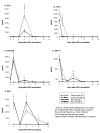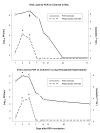Respiratory syncytial virus-induced acute and chronic airway disease is independent of genetic background: an experimental murine model
- PMID: 15916706
- PMCID: PMC1183251
- DOI: 10.1186/1743-422X-2-46
Respiratory syncytial virus-induced acute and chronic airway disease is independent of genetic background: an experimental murine model
Abstract
Background: Respiratory syncytial virus (RSV) is the leading respiratory viral pathogen in young children worldwide. RSV disease is associated with acute airway obstruction (AO), long-term airway hyperresponsiveness (AHR), and chronic lung inflammation. Using two different mouse strains, this study was designed to determine whether RSV disease patterns are host-dependent. C57BL/6 and BALB/c mice were inoculated with RSV and followed for 77 days. RSV loads were measured by plaque assay and polymerase chain reaction (PCR) in bronchoalveolar lavage (BAL) and whole lung samples; cytokines were measured in BAL samples. Lung inflammation was evaluated with a histopathologic score (HPS), and AO and AHR were determined by plethysmography.
Results: Viral load dynamics, histopathologic score (HPS), cytokine concentrations, AO and long-term AHR were similar in both strains of RSV-infected mice, although RSV-infected C57BL/6 mice developed significantly greater AO compared with RSV-infected BALB/c mice on day 5. PCR detected RSV RNA in BAL samples of RSV infected mice until day 42, and in whole lung samples through day 77. BAL concentrations of cytokines TNF-alpha, IFN-gamma, and chemokines MIG, RANTES and MIP-1alpha were significantly elevated in both strains of RSV-infected mice compared with their respective controls. Viral load measured by PCR significantly correlated with disease severity on days 14 and 21.
Conclusion: RSV-induced acute and chronic airway disease is independent of genetic background.
Figures


 ) and RSV inoculated (
) and RSV inoculated ( ) BALB/c mice, and sham inoculated (
) BALB/c mice, and sham inoculated ( ) and RSV inoculated (
) and RSV inoculated ( ) C57BL/6 mice from days 14 to 77. Values represent the mean SEM from 10–30 mice per group. Data shown are the result of four separate experiments. p < 0.05, comparison by t-test when data normally distributed, or by Mann-Whitney Rank sum test when data were not normally distributed.
) C57BL/6 mice from days 14 to 77. Values represent the mean SEM from 10–30 mice per group. Data shown are the result of four separate experiments. p < 0.05, comparison by t-test when data normally distributed, or by Mann-Whitney Rank sum test when data were not normally distributed.





Similar articles
-
Respiratory syncytial virus persistence in the lungs correlates with airway hyperreactivity in the mouse model.J Infect Dis. 2008 Nov 15;198(10):1435-43. doi: 10.1086/592714. J Infect Dis. 2008. PMID: 18828742 Free PMC article.
-
Respiratory syncytial virus induces pneumonia, cytokine response, airway obstruction, and chronic inflammatory infiltrates associated with long-term airway hyperresponsiveness in mice.J Infect Dis. 2004 May 15;189(10):1856-65. doi: 10.1086/386372. Epub 2004 Apr 29. J Infect Dis. 2004. PMID: 15122522
-
Lack of effect of bovine lactoferrin in respiratory syncytial virus replication and clinical disease severity in the mouse model.Antiviral Res. 2013 Aug;99(2):188-95. doi: 10.1016/j.antiviral.2013.05.013. Epub 2013 Jun 2. Antiviral Res. 2013. PMID: 23735300
-
Respiratory syncytial virus persistence: evidence in the mouse model.Pediatr Infect Dis J. 2008 Oct;27(10 Suppl):S60-2. doi: 10.1097/INF.0b013e3181684d52. Pediatr Infect Dis J. 2008. PMID: 18820580 Review.
-
Pathogenesis of respiratory syncytial virus infection in the murine model.Proc Am Thorac Soc. 2005;2(2):110-5. doi: 10.1513/pats.200501-002AW. Proc Am Thorac Soc. 2005. PMID: 16113477 Free PMC article. Review.
Cited by
-
Viral infection of the lungs through the eye.J Virol. 2007 Jan;81(2):783-90. doi: 10.1128/JVI.01437-06. Epub 2006 Oct 18. J Virol. 2007. PMID: 17050596 Free PMC article.
-
Molecular epidemiology and clinical characteristics of respiratory syncytial virus in hospitalized children during winter 2021-2022 in Bengbu, China.Front Public Health. 2024 Jan 3;11:1310293. doi: 10.3389/fpubh.2023.1310293. eCollection 2023. Front Public Health. 2024. PMID: 38235154 Free PMC article.
-
Respiratory syncytial virus persistence in the lungs correlates with airway hyperreactivity in the mouse model.J Infect Dis. 2008 Nov 15;198(10):1435-43. doi: 10.1086/592714. J Infect Dis. 2008. PMID: 18828742 Free PMC article.
-
Motavizumab, a neutralizing anti-Respiratory Syncytial Virus (Rsv) monoclonal antibody significantly modifies the local and systemic cytokine responses induced by Rsv in the mouse model.Virol J. 2007 Oct 25;4:109. doi: 10.1186/1743-422X-4-109. Virol J. 2007. PMID: 17961258 Free PMC article.
-
Transdermal Immunization with Microparticulate RSV-F Virus-like Particles Elicits Robust Immunity.Vaccines (Basel). 2022 Apr 10;10(4):584. doi: 10.3390/vaccines10040584. Vaccines (Basel). 2022. PMID: 35455333 Free PMC article.
References
-
- Sigurs N, Bjarnason R, Sigurbergsson F, Kjellman B. Respiratory syncytial virus bronchiolitis in infancy is an important risk factor for asthma and allergy at age 7. Am J Respir Crit Care Med. 2000;161:1501–1507. - PubMed
Publication types
MeSH terms
Substances
LinkOut - more resources
Full Text Sources
Medical
Research Materials

